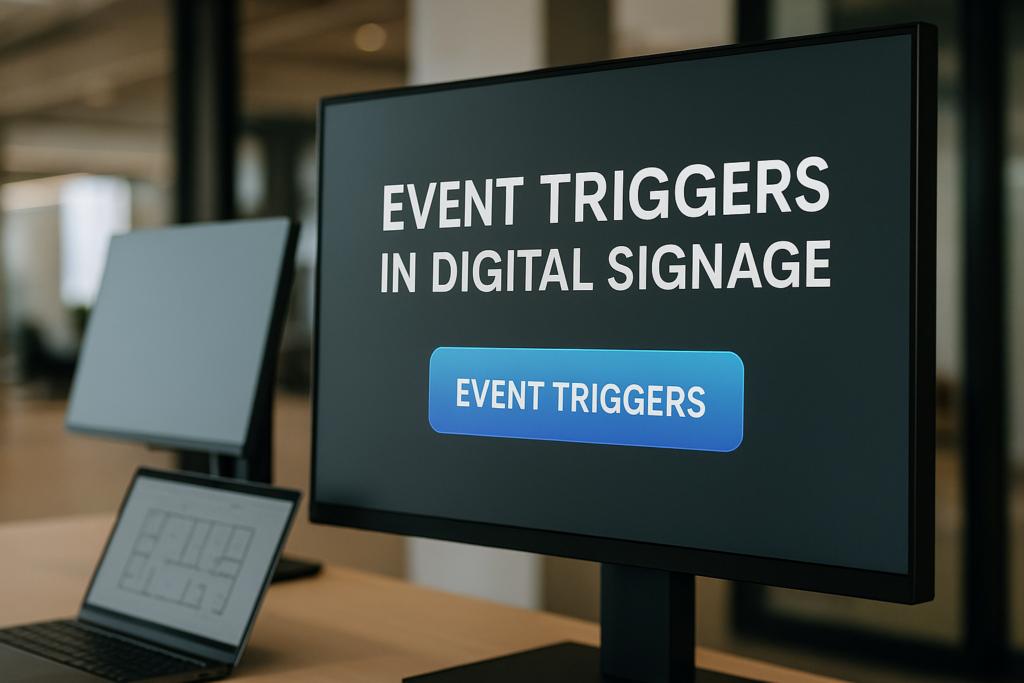Digital signage has come a long way in recent years, from basic video loops to dynamic, data-driven content that reacts in real time. At the heart of this transformation are event triggers. But what are they, and why are they changing the game?
In this blog, based on the first episode of TrouTalk, the digital signage podcast from TrouDigital, we explore how event triggers work, why they’re underused, and how they’re being enhanced by AI, custom dashboards, and modern hardware.
What Are Event Triggers in Digital Signage?
An event trigger is a mechanism that automatically changes what’s displayed on screen based on a real-world input. Rather than scheduling content manually, event triggers let your signage react to its environment, whether that’s the weather, a new email, or even someone walking past a screen.

Real-World Examples
- Weather-responsive advertising: On a hot day, screens automatically switch to promoting cold drinks.
- Internal communications: A Slack message or new support ticket triggers a real-time display update in the office.
- Retail interactivity: Motion sensors or touchscreen interactions swap content based on what a customer touches or views.
These aren’t just gimmicks. They improve engagement, relevance, and automation.
The Rise of Smart Signage: From Manual to Automated
When digital signage first became mainstream, content management was mostly manual. Users had to update media players by hand or upload new files to a central CMS.
Fast forward a few years and things have changed dramatically. As Jordan, Technical Lead at TrouDigital, explains on the podcast:
“When I first started, our media players could barely handle scrolling text. Now, we can display live dashboards, pull in data from APIs, and do it all without a stutter.”
Event triggers play a big part in this evolution. They allow signage to react and adapt without anyone lifting a finger.
AI and Event Triggers: Smarter Displays with Less Effort
Artificial Intelligence is helping businesses get even more from their screens. AI can:
- Generate content automatically based on a prompt (e.g. “Show a hydration reminder”)
- Interpret sensor data to decide what to display
- Optimise screen performance using diagnostics and behavioural insights
TrouDigital has already explored AI tools that enable users to type a message, such as “Congratulations to our new starters,” and have the signage system design a display for them, with no graphic design required.
One powerful example is AI that analyses screen downtime and identifies behavioural patterns, such as someone turning off a screen each evening. Previously, such patterns would go unnoticed for months.
Video Walls: From Costly Clunk to Android Simplicity
Another key theme from the podcast is how video wall technology has become dramatically more accessible.
Whereas running a six-screen video wall used to require expensive PCs and fan-driven systems, it can now be achieved using fanless Android devices or compact Chrome OS players.
This has made advanced signage setups, such as synchronised menu boards at service stations or large-scale retail installations, far more affordable and easier to manage. When paired with event triggers, the impact is even greater.
Custom Dashboards: Making Data Visible Across Teams
Screens are no longer just for marketing. They are now essential tools for internal communication.
Using integrations with Power BI, Tableau, Google Sheets, and more, it’s possible to display live dashboards on any screen across your organisation. This is especially valuable for:
- Remote teams: Ensure visibility across hybrid work environments.
- Sales teams: Show performance against KPIs.
- Support teams: Automatically surface new tickets and messages.
And because the data is pulled directly from existing workflows, there’s no need to replicate or reformat information.
APIs: The Backbone of Dynamic Digital Signage
To enable everything above—AI, dashboards, triggers—you need robust APIs. These allow your signage software to communicate with other tools and services.
As described in the podcast:
“An API is like a waiter. You place an order, and it goes to the kitchen (the web server) and brings back your data.”
Whether it’s pulling in weather updates, syncing with Slack, or integrating with Microsoft Teams, APIs unlock automation and flexibility in signage like never before.
A Glimpse at the Future
The podcast wraps up with a discussion on where the signage industry is heading. Here are some of the highlights:
- Anonymous facial recognition: Gain insights into demographics and sentiment without breaching privacy.
- Touchless interactivity: Use proximity sensors and gestures instead of touch.
- Smarter outdoor displays: Slimmer, fanless, weatherproof screens with enhanced readability.
- AI-driven analytics: Natural language reports for screen performance and audience engagement.
As Jordan put it, “It feels like we’re just at the crest of the wave. It’s all about to happen.”
Final Thoughts
Event triggers in digital signage are more than a feature. They represent a shift in thinking. They transform signage from a static tool into an intelligent, responsive platform that enhances communication, whether you’re a retail brand, corporate office, or public institution.
With AI, modern hardware, and integrations like Power BI and Slack, the possibilities are nearly endless. As technology continues to evolve, businesses that adopt these innovations early will be the ones that stand out.
Want to explore how event triggers can transform your signage?
Get in touch with the TrouDigital team to find out how we can help you create smarter, more dynamic screens.
